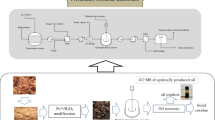Abstract
The deterpenation of orange peel oil in most industries is accomplished by vacuum distillation, but surprisingly little information on this matter can be found in the open literature. This work reports recent results on orange peel oil deterpenation carried out in an automatic vacuum distillation column operated in the semibatch mode at the temperatures of 50, 65, and 80°C, at 10, 20, and 30 mbar, and with reflux ratios of 0.25, 0.50, and 0.75. The concentrates were analyzed with regard to the oxygenate compound content by gas chromatography coupled with a mass spectrometer (GC-MS) and evaluated by sensory analysis, and also with regard to the aldehyde content. As one could expect, there is a strong relationship between oil quality, as revealed by the sensory analysis, and chemical composition, as determined by GC-MS. The concentration factor and process yield, as expressed by “fold,” together with the analysis results show that it is possible to obtain high quality concentrates simply by manipulating the operating variables in the vacuum fractionation process.
Similar content being viewed by others
References
Stuart, G.R., D. Lopes, and J.V. Oliveira, Current Investigations on Orange Peel Oil Fractionation, Perfum. Flavor. 26:8–15 (2001).
Budich, M., S. Heilig, T. Wesse, V. Leibkuchler, and G. Brunner, Countercurrent Deterpenation of Citrus Oils with Supercritical CO2, J. Supercrit. Fluids 14:105–114 (1999).
Sato, M., M. Kondo, M. Goto, A. Kodama, and T. Hirose, Fractionation of Citrus Oil by Supercritical Countercurrent Extractor with Side-Stream Withdrawal, 13:311–317 (1998).
Lifshitz, A., Y. Stepak, and I. Elroy, Objective Evaluation of the Degree of Concentration of Citrus Oils, Perfum. Essent. Oil Rec. 60:157–165 (1969).
Vora, J.D., R.F. Matthews, P.G. Crandall, and R. Cook, Preparation and Chemical Composition of Orange Oil Concentrates, J. Food Sci. 48:1197–1199 (1983).
Stuart, G.R., Estudo do Processo de Fracionamento do Óleo de Laranja por Destilação a Vácuo e Dióxido de Carbono Supercrítico, Ph.D. Thesis, Programa de Engenharia Química-COPPE-Universidade Federal do Rio de Janeiro, Rio de Janeiro, Brazil, 1999 (in Portuguese).
United States Pharmacopeia, 19th rev., Mack Publishing, Easton, PA, 1975.
Guenther, E., The Essential Oils, Krieger Publishing, New York, 1972, p. 224.
Author information
Authors and Affiliations
Corresponding author
About this article
Cite this article
Stuart, G.R., Lopes, D. & Oliveira, J.V. Deterpenation of Brazilian orange peel oil by vacuum distillation. J Amer Oil Chem Soc 78, 1041–1044 (2001). https://doi.org/10.1007/s11746-001-0385-x
Received:
Accepted:
Issue Date:
DOI: https://doi.org/10.1007/s11746-001-0385-x




